November 5, 1912 1916 → 435 88 6,296,284 4,122,721 Date 5 November 1912 | Turnout 58.8% 6.6 pp 40 6 41.8% 27.4% Location United States of America | |
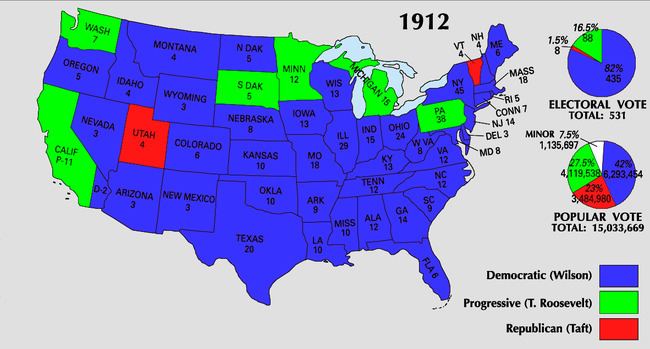 | ||
Winner Woodrow Wilson Other Instances United States presidenti, United States presidenti, United States presidenti, United States presidenti, United States presidenti | ||
The United States presidential election of 1912 was the 32nd quadrennial presidential election, held on Tuesday, November 5, 1912. The election was a rare four-way contest. Incumbent President William Howard Taft was renominated by the Republican Party with the support of its conservative wing. After former President Theodore Roosevelt failed to receive the Republican nomination, he called his own convention and created the Progressive Party (nicknamed the “Bull Moose Party”). It nominated Roosevelt and ran candidates for other offices in major states. Democrat Woodrow Wilson was finally nominated on the 46th ballot of a contentious convention, thanks to the support of William Jennings Bryan, the three-time Democratic presidential candidate who still had a large and loyal following in 1912. Meanwhile, the Socialist Party of America renominated its perennial standard-bearer, Eugene V. Debs. It is the last election in which a former, or incumbent, President (Roosevelt) ran for the office without being nominated as either a Democrat or Republican. It is also the last election in which an incumbent President running for re-election (Taft) failed to finish either first or second in the popular vote count.
Contents
- Background
- Republican Party nomination
- Progressive Party
- Democratic Party nomination
- Socialist Party nomination
- Campaign
- Results
- Close states
- Statistics
- Consequences
- References
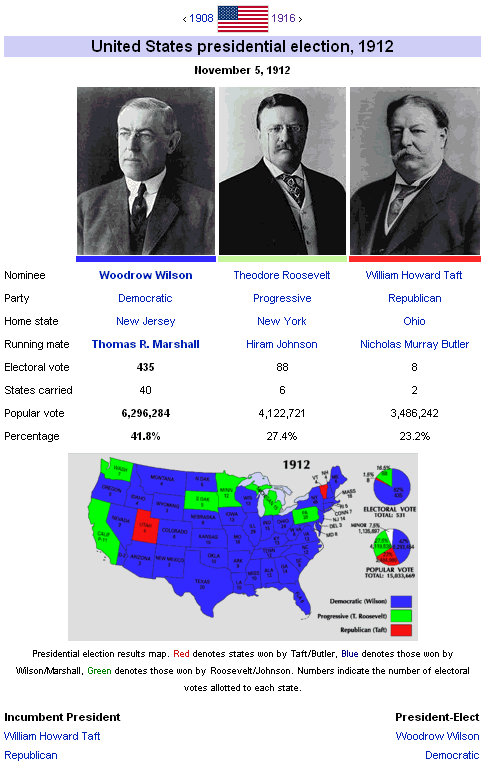
Wilson won the election, gaining a large majority in the Electoral College and winning 42% of the popular vote, while Roosevelt won 27%, Taft 23% and Debs 6%. Wilson became the only elected president from the Democratic Party between 1896 and 1932, and the second of only two Democrats to be elected president between 1860 and 1932. This was the last election in which a candidate who was not a Republican or Democrat came second in either the popular vote or the Electoral College, and the first election in which all current 48 states of the contiguous United States participated. This was also the last election in which more than one nominee had previously been elected President.

Background

Republican President Theodore Roosevelt had declined to run for re-election in 1908 in fulfillment of a pledge to the American people not to seek a second full term. Roosevelt's first term as president (1901–1905) was incomplete, as he succeeded to the office upon the assassination of William McKinley; it was only his second term (1905–1909) that encompassed four full years. He had tapped Secretary of War William Howard Taft to become his successor, and Taft defeated Democrat William Jennings Bryan in the general election.

During Taft's administration, a rift grew between Roosevelt and Taft as they became the leaders of the Republican Party's two wings: the progressives, led by Roosevelt, and the conservatives, led by Taft. The progressive Republicans favored restrictions on the employment of women and children, promoted ecological conservation, and were more sympathetic toward labor unions. The progressives were also in favor of the popular election of federal and state judges and opposed to having judges appointed by the president or state governors. The conservatives were in support of high tariffs on imported goods to encourage consumers to buy American-made products (as were most progressives), favored business leaders over labor unions, and were generally opposed to the popular election of judges.
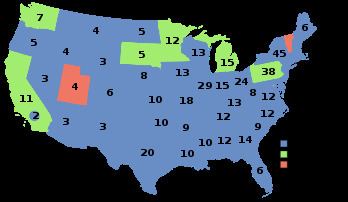
By 1910 the split between the two wings of the Republican Party was deep, and this, in turn, caused Roosevelt and Taft to turn against one another, despite their personal friendship. Taft's popularity among progressives collapsed when he supported the Payne-Aldrich Tariff Act in 1909, abandoned Roosevelt's anti-trust policy and fired popular conservationist Gifford Pinchot as head of the Bureau of Forestry in 1910.
Republican Party nomination
Republican candidates:
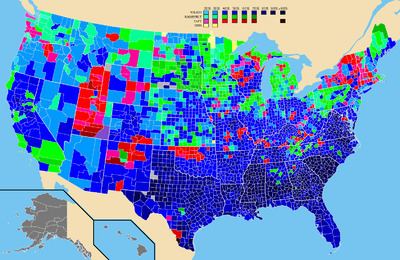
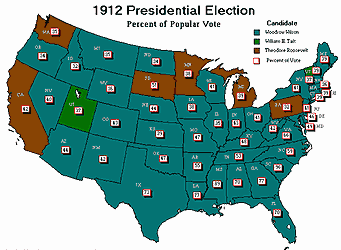
For the first time, significant numbers of delegates to the national conventions were elected in presidential preference primaries. Primary elections were advocated by the progressive faction of the Republican Party, which wanted to break the control of political parties by bosses. Altogether, twelve states held Republican primaries. Robert M. La Follette won two of the first four primaries (North Dakota and Wisconsin). Beginning with his runaway victory in Illinois on April 9, however, Roosevelt won nine of the last ten presidential primaries (in order, Illinois, Pennsylvania, Nebraska, Oregon, Maryland, California, Ohio, New Jersey, and South Dakota), losing only Massachusetts to Taft. As a sign of his great popularity, Roosevelt even carried Taft's home state of Ohio.
The Republican Convention was held in Chicago from June 18 to 22. Taft, however, had begun to gather delegates earlier, and the delegates chosen in the primaries were a minority. Taft had the support of the bulk of the party organizations in the Southern states. These states had voted solidly Democratic in every presidential election since 1880, and Roosevelt objected that they were given one-quarter of the delegates when they would contribute nothing to a Republican victory (as it turned out, delegates from the former Confederate states supported Taft by a 5 to 1 margin). When the convention gathered, Roosevelt challenged the credentials of nearly half of the delegates. By that time, however, it was too late. The delegates chose Elihu Root — once Roosevelt's top ally — to serve as chairman of the convention. Afterwards, the delegates seated Taft delegations in Alabama, Arizona, and California on tight votes of 597-472, 564-497, and 542-529, respectively. After losing California, where Roosevelt had won the primary, the progressive delegates gave up hope. They voted "present" on most succeeding roll calls. Not since the 1872 election had there been a major schism in the Republican party. Now, with the Democrats holding about 45% of the national vote, any schism would be fatal. Roosevelt's only hope at the convention was to form a "stop-Taft" alliance with La Follette, but Roosevelt had alienated La Follette, and the alliance could not form.
Unable to tolerate the personal humiliation he suffered at the hands of Taft and the Old Guard, and refusing to entertain the possibility of a compromise candidate, Roosevelt struck back hard. On the evening of June 22, 1912, Roosevelt asked his supporters to leave the convention. Roosevelt maintained that President Taft had allowed fraudulent seating of delegates to capture the presidential nomination from progressive forces within the Party. Thus, with the support of convention chairman Elihu Root, Taft's supporters outvoted Roosevelt's men, and the convention renominated incumbents William Howard Taft and James S. Sherman, making Sherman the first sitting vice-president to be nominated for re-election since John C. Calhoun in 1828.
Progressive Party
Progressive candidate:
Republican progressives reconvened in Chicago and endorsed the formation of a national progressive party. When formally launched later that summer, the new Progressive Party chose Roosevelt as its presidential nominee and Governor Hiram Johnson from California as his vice presidential running mate. Questioned by reporters, Roosevelt said he felt as strong as a "bull moose". Henceforth known as the "Bull Moose Party," the Progressives promised to increase federal regulation and protect the welfare of ordinary people.
The party was funded by publisher Frank Munsey and its executive secretary George Walbridge Perkins, an employee of banker J. P. Morgan and International Harvester. Perkins blocked an anti-trust plank, shocking reformers who thought of Roosevelt as a true trust-buster. The delegates to the convention sang the hymn "Onward, Christian Soldiers" as their anthem. In a famous acceptance speech, Roosevelt compared the coming presidential campaign to the Battle of Armageddon and stated that the Progressives were going to "battle for the LORD." However, many of the nation's newspapers, which tended to be pro-Republican, harshly depicted Roosevelt as an egotist who was only running for president to spoil Taft's chances and feed his vanity. Many of these newspapers' political cartoons portrayed Roosevelt in this fashion; the anti-Roosevelt cartoon below was drawn by Edward Windsor Kemble for the January 1912 edition of Harper's Weekly.
Democratic Party nomination
Democratic candidates:
The Democratic Convention was held in Baltimore, Maryland, from June 25 to July 2. It proved to be one of the more memorable presidential conventions of the twentieth century. Initially, the frontrunner appeared to be Champ Clark of Missouri, the Speaker of the House, and Clark did receive the largest number of delegate votes early in the balloting. However, he was unable to get the two-thirds majority required to win the nomination. His chances were hurt when Tammany Hall, the powerful and corrupt Democratic political machine in New York City, threw its support behind Clark. Instead of helping him, this led William Jennings Bryan, the three-time Democratic presidential candidate and still the leader of the party's progressives, to turn against Clark as the candidate of "Wall Street". Bryan instead threw his support to New Jersey Governor Woodrow Wilson, who had consistently finished second to Clark on each ballot, and who was regarded as a moderate reformer. Wilson had nearly given up hope that he could be nominated, and he was on the verge of having a concession speech read for him at the convention that would free his delegates to vote for someone else. Bryan's defection from Clark to Wilson led many other delegates to do the same, and Wilson gradually gained strength while Clark's support dwindled. Wilson finally received the nomination on the 46th ballot.
Thomas R. Marshall, the Governor of Indiana, who had swung his state's delegate votes to Wilson in later ballots, was named as Wilson's running mate.
Socialist Party nomination
Socialist candidates:
The Socialist Party of America was a highly factionalized coalition of local parties based in industrial cities and usually was rooted in ethnic communities, especially German and Finnish. It also had some support in old Populist rural and mining areas in the West, especially Oklahoma. By 1912, the party claimed more than a thousand locally elected officials in 33 states and 160 cities, especially the Midwest. Eugene V. Debs had run for president in 1900, 1904, and 1908, primarily to encourage the local effort, and he did so again in 1912 and from prison in 1920.
The conservatives, led by Victor L. Berger from Milwaukee, promoted progressive causes of efficiency and an end to corruption, nicknamed "gas and water socialism." Their opponents were the radicals who wanted to overthrow capitalism, tried to infiltrate labor unions, and sought to cooperate with the Industrial Workers of the World ("the Wobblies"). With few exceptions, the party had weak or nonexistent links to local labor unions. Immigration was an issue—the radicals saw immigrants as fodder for the war with capitalism, while conservatives complained that they lowered wage rates and absorbed too many city resources. Many of these issues had been debated at the First National Congress of the Socialist Party in 1910, and they were debated again at the national convention in Indianapolis in 1912. At the latter, the radicals won an early test by seating Bill Haywood on the Executive Committee, sending encouragement to western "Wobblies", and passed a resolution seeming to favor industrial unionism. The conservatives counterattacked by amending the party constitution to expel any socialists who favored industrial sabotage or syndicalism (that is, the IWW), and who refused to participate in American elections. They adopted a conservative platform calling for cooperative organization of prisons, a national bureau of health, abolition of the Senate and the presidential veto. Debs did not attend; he saw his mission as keeping the disparate units together in the hope that someday a common goal would be found.
Campaign
The 1912 presidential campaign was bitterly contested. Vice-President James S. Sherman died in office on October 30, 1912, less than a week before the election, leaving Taft without a running mate. (Nicholas M. Butler was designated to receive electoral votes that would have been cast for Sherman.) With the Republican Party divided, Wilson captured the presidency handily on November 5.
While Roosevelt was campaigning in Milwaukee on October 14, 1912, a saloonkeeper named John Flammang Schrank shot him, but the bullet lodged in his chest only after penetrating both his steel eyeglass case and a 50-page single-folded copy of the speech he was to deliver, carried in his jacket pocket. In keeping with his he-man image, Roosevelt gave his speech before seeking medical attention.
The election of 1912 is considered the high tide of progressive politics. Had either Roosevelt or Taft stayed out of the race, a Republican victory would have been assured.
The Socialists had little money; Debs' campaign cost only $66,000, mostly for 3.5 million leaflets and travel to rallies organized by local groups. His biggest event was a speech to 15,000 supporters in New York City. The crowd sang "La Marseillaise" and "The Internationale" as Emil Seidel, the vice- presidential candidate, boasted, "Only a year ago workingmen were throwing decayed vegetables and rotten eggs at us but now all is changed... Eggs are too high. There is a great giant growing up in this country that will someday take over the affairs of this nation. He is a little giant now but he is growing fast. The name of this little giant is socialism." Debs said that only the socialists represented labor. He condemned "Injunction Bill Taft" and ridiculed Roosevelt as "a charlatan, mountebank, and fraud, and his Progressive promises and pledges as the mouthings of a low and utterly unprincipled self seeker and demagogue." Debs insisted that the Democrats, Progressives, and Republicans alike were financed by the trusts. Party newspapers spread the word—there were five English-language and eight foreign-language dailies along with 262 English and 36 foreign-language weeklies. The labor union movement, however, largely rejected Debs and supported Wilson.
Roosevelt conducted a vigorous national campaign for the Progressive Party, denouncing the way the Republican nomination had been "stolen". He bundled together his reforms under the rubric of "The New Nationalism" and stumped the country for a strong federal role in regulating the economy and chastising bad corporations. Wilson supported a policy called "The New Freedom". This policy was based mostly on individualism instead of a strong government. Taft campaigned quietly, and spoke of the need for judges to be more powerful than elected officials. The departure of the more progressive Republicans left the conservative Republicans even more firmly in control of their party until 1916, when many progressives returned. Much of the Republican effort was designed to discredit Roosevelt as a dangerous radical, but this had little effect.
Results
The impact of the third-party vote is indicated by the fact that few states were carried by a majority of the popular vote. Taft carried two states (Utah and Vermont), Roosevelt six, and Wilson forty. Taft carried no state with a popular majority, Roosevelt one (South Dakota, where there was no Republican ticket), and Wilson eleven, all of them states of the former Confederacy. More than two-thirds of Wilson’s total vote was cast in the 37 states that he did not carry by majority vote.
Wilson’s vote, 6,296,919, was less than William Jennings Bryan totaled in any one of his campaigns, and over 100,000 less than Bryan received in 1908, when Bryan won only 162 electoral votes. Wilson fell behind the Bryan strength in most of the country, and notably so in Pennsylvania, Ohio, Indiana, Illinois, Michigan, Nebraska, Kansas, South Carolina, Kentucky, and Arkansas. In only two sections was Wilson’s vote greater than the greatest Bryan vote: New England and the Pacific. Wilson led the poll in 1,969 counties, but he received a majority of the vote in only 1,237 counties, less than Bryan had had in any of his campaigns. Taft had a majority in only 35, and "Other(s)" in only 305. These small figures clearly reveal the result of the division of the normal Republican vote, as does the fact that in a plurality of counties (1,396) no candidate obtained a majority. Taft had a lead over the field in only 232 counties. In addition to South Dakota and California, where there was no Taft ticket, and seven “Solid South” states in which he carried no county, Taft also carried no counties in Maine, New Jersey, Minnesota, Nevada and Arizona. Nine counties did not record any votes due to either black disenfranchisement or being inhabited only by Native Americans who would not gain full citizenship for twelve more years.
The 772 counties not carried by Wilson or by Taft were distributed in 38 states, most of them in Pennsylvania (48), Illinois (33), Michigan (68), Minnesota (75), Iowa (49), South Dakota (54), Nebraska (32), Kansas (51), Washington (38), and California (44), and almost without exception were carried by Roosevelt. Debs carried four counties in Minnesota (Lake and Beltrami), North Dakota (Burke County), and Kansas (Crawford County), the only counties ever to vote socialist in a presidential election.
Source (Popular Vote): Leip, David. "1912 Presidential Election Results". Dave Leip's Atlas of U.S. Presidential Elections. Retrieved July 28, 2005.
Source (Electoral Vote): "Electoral College Box Scores 1789–1996". National Archives and Records Administration. Retrieved July 31, 2005.
Close states
Margin of victory less than 1% (13 electoral votes):
- California, 0.03%
Margin of victory less than 5% (142 electoral votes):
- Idaho, 1.05%
- Illinois, 1.62%
- Wyoming, 1.77%
- Vermont, 1.91%
- Maine, 2.02%
- New Hampshire, 2.04%
- Connecticut, 3.28%
- Rhode Island, 3.48%
- Massachusetts, 3.58%
- Pennsylvania, 4.04%
- North Dakota, 4.42%
- Iowa, 4.77%
- Utah, 4.91%
Margin of victory between 5% and 10% (73 electoral votes):
- New Mexico, 5.48%
- Minnesota, 5.81%
- Kansas, 6.42%
- Montana, 6.87%
- Oregon, 6.91%
- New Jersey, 7.60%
- Washington, 8.32%
- Wisconsin, 8.41%
- South Dakota, 8.48%
Statistics
Counties with Highest Percent of Vote (Democratic)
- Greenville County, South Carolina 100.00%
- Marlboro County, South Carolina 100.00%
- Hampton County, South Carolina 100.00%
- Jasper County, South Carolina 100.00%
- Reagan County, Texas 100.00%
Counties with Highest Percent of Vote (Other)
- Scott County, Tennessee 82.80%
- Campbell County, South Dakota 80.42%
- Clearwater County, Minnesota 77.35%
- Avery County, North Carolina 72.84%
- Cook County, Minnesota 72.70%
Counties with Highest Percent of Vote (Republican)
- Zapata County, Texas 80.89%
- Valencia County, New Mexico 77.25%
- Kane County, Utah 75.40%
- Clinton County, Kentucky 64.79%
- Huerfano County, Colorado 63.36%
Consequences
Failing to make itself a believable third party, the Bull Moose Party ended up losing strength. Its candidates did poorly in 1914. It vanished in 1916 with most members following Roosevelt back into the Republican party. However, the Taft conservatives controlled the party and its platform from 1912 to 1928, and thus some Progressives like Harold L. Ickes joined the steadily more liberal Democratic party.
The election of 1912 was the topic of counterfactual speculation by John Lukacs, “The Election of Theodore Roosevelt, 1912’, in What If? 2, edited by Robert Cowley.
